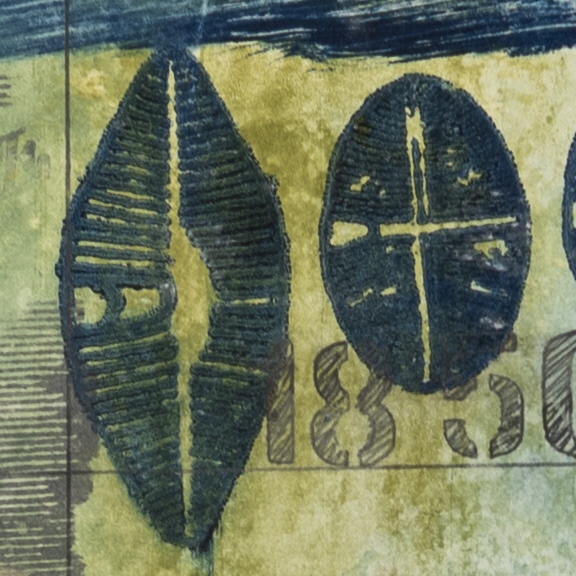
Ann Forbush
Annotated Ocean AS26 1
Monoprint with collage
……..
Sallie Chisholm
Institute Professor
Civil and Environmental Engineering
Department of Biology
Massachusetts Institute of Technology
I am a biological oceanographer. I study life in the oceans and how it interacts with ocean chemistry and the atmosphere. More specifically I study planktonic microorganisms that form the base of the food web, the phytoplankton. My lab is focused almost exclusively on the study of a tiny microbe called Prochlorococcus which dominates vast ocean regions and is the smallest and most abundant photosynthetic organism on the planet. Through photosynthesis, it converts as much carbon dioxide into living matter each year as do all the crops on land. This amazing little powerhouse was discovered only about 35 years ago.
When I look at this work of art, which includes renderings of phytoplankton, I see beauty. I see change. I see large and small. I see the footprint of humans, and our tendency to think of nature as we know it as the way it has always been; the ever-shifting baseline of what is “natural” is opaque to us. Unlike ancient structures, hieroglyphics, or transcripts, ancient ecosystems cannot be observed. They live only in our imagination. Like works of art, they are self-assembled masterpieces built from the complex interplay between the living and non-living world. But unlike most works of art, they are ephemeral.
The scientific method and the creative process appear at first glance at odds with one another. But are they? The scientific method begins with a hypothesis that can be tested – either through manipulative experiments or observations of patterns in nature. This is science’s way of knowing. It involves a roadmap. The creative process seems to begin with a blank slate. The artist’s inspiration can come completely from within, or be triggered externally. But there are no rules; there is no roadmap. Once begun, art can go in any direction. Not unlike a scientific experiment!

Je suis biologiste océanographe. Nous étudions la vie des océans et ses interactions avec la chimie et l’atmosphère. Plus précisément nous étudions les microorganismes planctoniques qui se forment à la base de la chaîne alimentaire. Mon laboratoire se focalise presque exclusivement sur l’étude d’un tout petit microbe appelé Prochlorococcus, qui domine de vastes régions de l’océan et qui est l’organisme photosynthétique le plus petit de la planète. Par photosynthèse, chaque année, le prochlorococcus convertit autant de dioxyde de carbone en matière organique que toutes les plantes sur terre réunies. Cette fabuleuse usine minuscule a été découverte il y a seulement 35 ans.
Je vois de la beauté, du changement, de la grandeur et de la petitesse. Je vois l’impact des humains et notre tendance à penser que la nature que nous connaissons est celle qu’elle a toujours été. L’essence de changement perpétulle de ce qui est naturel nous est opaque. Contrairement à des structures anciennes, des hiéroglyphes, des parchemins, les anciens écosystèmes ne peuvent pas être observés. Ils ne vivent que dans notre imagination. Comme des pièces d’art, ils s’assemblent d’eux-mêmes en oeuvres construites depuis l’échange complexe entre le vivant et le non vivant. Mais contrairement à la plupart des oeuvres d’art, ils sont éphémères.
Typiquement, on imagine la méthode scientifique comme débutant avec une hypothèse qui peut être testée, soit par des expériences soit par des observations de modèles dans la nature. C’est la façon dont la science sait, cela suit un itinéraire. Le procédé créatif semble débuter avec une page blanche. L’inspiration de l’artiste peut être spontanée ou déclenchée par des facteurs externes. Il n’y a ni règles, ni itinéraire. Une fois débutés, les projets artistiques peuvent aller en toutes directions, tout comme les expériences scientifiques!